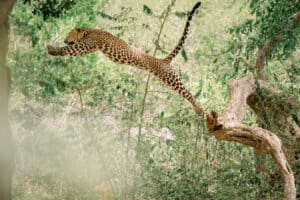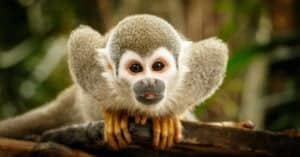As humans, we are obsessed with finding life forms similar to ours. Thankfully, we don’t have to look too far. The monkey inhabitants of our planet are often startlingly similar to us, with humanoid faces, opposable thumbs, and clever minds. But with primates of all kinds in danger of extinction, just how many monkeys are in the world? Find out the answer to this and much more!
What is a Monkey?
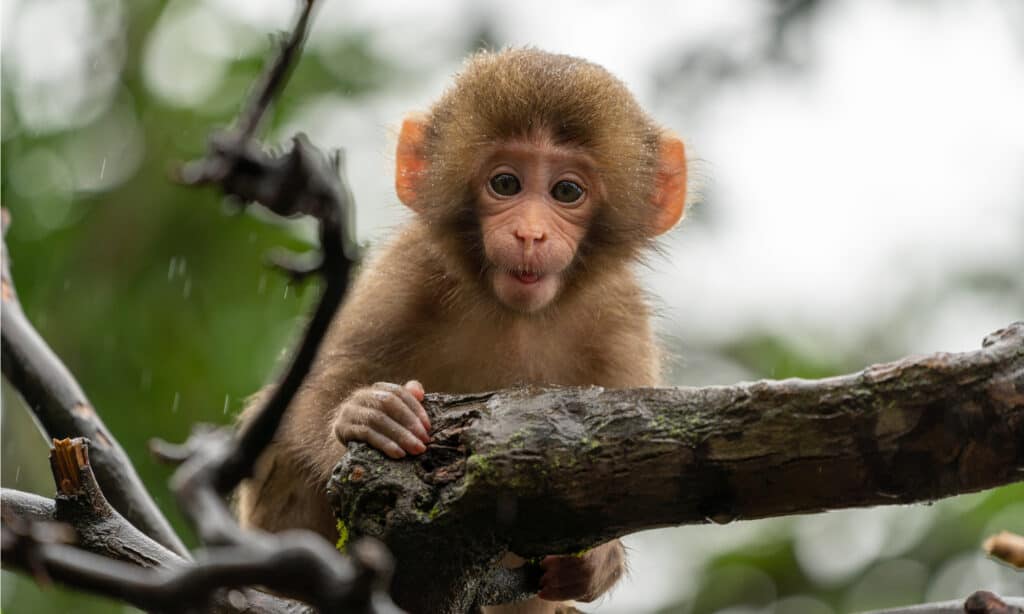
There are over 200 species of monkeys in the world, which are divided into Old World and New World Monkeys.
©exs_yori/Shutterstock.com
Monkeys are one of over 200 species of tailed primates. It belongs to one of two groups: Old World monkeys or New World monkeys. New World monkeys came along more recently in evolutionary history, branching off from Old World monkeys about 40 million years ago.
Old World Monkeys
The scientific name for Old World monkeys is Cercopithecidae. They belong to the group known as catarrhines, meaning “downward-nosed.” This refers to the shape of their noses, which have nostrils pointing down. Humans and apes also belong to this group and are related to Old World monkeys.
There are 138 species of monkeys that comprise this group. Most of them have tails, though they are not prehensile (that is, able to grasp objects). They have opposable thumbs to grab and manipulate objects.
Examples of Old World monkeys include macaques, baboons, and mandrills.
New World Monkeys
The scientific name for New World monkeys is Platyrrhini. They are also known as platyrrhines or “flat-nosed” monkeys. Once again, this refers to the shape of their noses: flat, with the nostrils opening outward.
There are over 100 species of New World monkeys. They have long, prehensile tails but lack a proper opposable thumb. For this reason, they often use their dexterous tails to grasp objects.
Examples of New World monkeys include howler monkeys, spider monkeys, capuchin monkeys, and tamarins.
How Many Monkeys Are in the World?
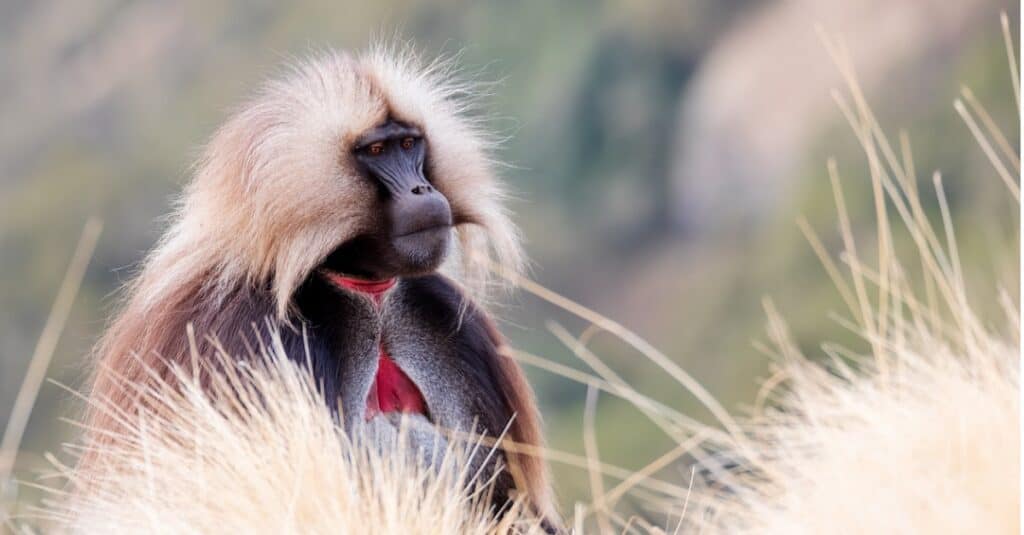
The IUCN lists the gelada as having a total population of about 200,000 individuals.
©Artush/Shutterstock.com
There are over 200 species of monkeys in the world today. Because monkeys can be elusive in the wild, they are hard to count as individuals. However, we can guess the numbers of some individual species. The International Union for Conservation of Nature (IUCN) lists the gelada as having a total population of about 200,000 individuals. This makes it the most populous species of monkeys in the world today. However, humans are the most populous primates on Earth at about 7.8 billion.
Where Are Monkeys Found?
Monkeys thrive in tropical rainforests across the globe. Old World monkeys live in Africa and Asia, while New World monkeys inhabit Central and South America. In fact, monkeys are found on all continents except Australia and Antarctica.
Why not Australia? Its temperate rainforests in the south seem like a viable option. The reason appears to be the breaking up of the supercontinent Pangea 175 million years ago. Primates were likely too far away from Australia to inhabit the new continent. Once it separated from the rest of Pangea, there was no way for primates to get there. Now, monkeys would be considered an invasive species if humans ever brought them over.
Antarctica, on the other hand, requires little explanation. It is obviously far too cold. Besides this, there are no forests or appropriate food sources to sustain a population of monkeys.
Though they usually prefer rainforests, some species also live in mountainous regions or on the African savanna. They are highly mobile, constantly moving around in search of food.
Monkey Diet and Predators
Most people assume monkeys are herbivores, as they often snack on various fruits. However, most are actually omnivores, requiring some form of protein in their diet. Common plant food sources are nuts, seeds, gum, fruits, leaves, and grass. Preferred fruits include mangoes and various berries. Contrary to popular belief, monkeys rarely have access to bananas in the wild.
Carnivorous monkeys may also eat bird eggs, birds, bats, lizards, squirrels, snails, insects, and other invertebrates. However, most monkeys lean toward a plant-based diet.
Monkeys face threats from a number of sources. Big cats like lions, tigers, and leopards pose a serious threat. Large birds of prey can easily swoop down on monkeys perching in high trees. Hyenas, crocodiles, and alligators are also potential predators. Humans often hunt monkeys for food, for retaliation, or for sport.
The World’s Biggest Monkey

The mandrill is the world’s biggest monkey.
©Nikolay 007/Shutterstock.com
The world’s biggest monkey is the mandrill, an Old World monkey living in the rainforests of West-Central Africa. It is mostly found in Guinea, Cameroon, Gabon, and the Congo. Adult male mandrills can weigh as much as 119 pounds with a body length of 30-37 inches.
Closely related to baboons, they inspired praise from Charles Darwin for their remarkable coloring. With yellow and blue ruffs around its face with bright blue and pink snouts, the male mandrill is indeed a spectacle. Females are much smaller than males and lack this coloring.
Unfortunately, the IUCN lists the mandrill as vulnerable to extinction.
The World’s Smallest Monkey
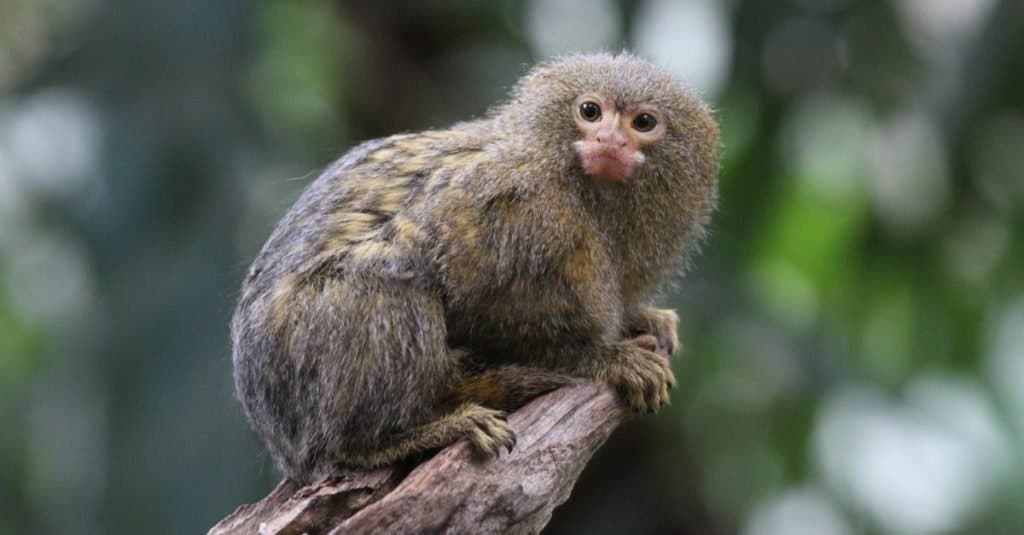
The pygmy marmoset is the world’s smallest monkey.
©Mihai Ivascu/Shutterstock.com
The world’s smallest monkey is the pygmy marmoset, an adorable and dexterous New World monkey. It averages 5.1 inches in length with a weight of 3.5 ounces. Because of its diminutive size, it is also known as the finger monkey.
It is able to leap a remarkable 16 feet through the air, making it an adept tree-dweller. It chooses to live on the tops of trees found in the South American rainforests. Several predators stalk it due to its size. This includes a number of birds of prey like eagles and hawks.
The IUCN lists pygmy marmosets as threatened due to the depletion of their habitat.
Monkeys as Pets
Some people keep monkeys as a type of exotic pet. Their humanlike faces and intelligent demeanor are part of the allure. In many places in the world, however, it is illegal to keep a monkey as a pet. This is mostly due to the high level of maintenance required to keep a primate happy and healthy.
Keeping monkeys under control is yet another problem. Generally, monkeys are difficult pets to keep in the home. They are hard to housetrain, meaning they usually need diapers. Worse, they can be hard to control. Some display aggression toward other animals or even their owners, and their strength and agility put their targets at a serious disadvantage. Opposable thumbs and prehensile tails are well-suited to getting into mischief. In addition to this, they have specific habitat needs that most environments can’t effectively provide.
Add the enormous cost of buying and maintaining such exotic pets, and most people would not seriously consider getting a pet monkey. Those that do favor species like tamarins and squirrel monkeys.
Endangered Monkey Species

Over half of all primates on Earth are on the endangered list, including capuchin monkeys.
©Ondrej Prosicky/Shutterstock.com
Over half of all primates are on the IUCN’s Red List. Many of these species include monkeys, both Old and New World. Examples of Old World endangered species are the Roloway monkey and the kipunji monkey. Some New World examples are the black-headed spider monkey, Rio Maya titi, and Ecuadorian capuchin.
Why are monkeys threatened with extinction? Habitat loss is the primary reason. As tropical rainforests diminish in size, primates find themselves scrambling for new territory. The loss of land also means the loss of food sources, both plants and animals. Another reason is poaching. Humans often hunt monkeys either for food or as part of the illegal pet trade.
Monkeys are resilient, clever individuals who share much in common with humans. Action to protect some of our closest animal relatives is necessary to ensure their continued survival.
The photo featured at the top of this post is © Ludmila Ruzickova/Shutterstock.com
Thank you for reading! Have some feedback for us? Contact the AZ Animals editorial team.





